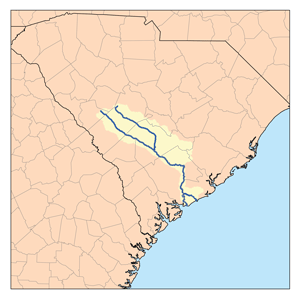
Edisto Beach is a town in Colleton County, South Carolina, United States. Edisto Beach's population was 414 as of the 2010 census, down from 641 in 2000. The town limits include only the developed coastal area of Edisto Island within Colleton County, while the majority of the island consists of unincorporated land in Charleston County. Due to its status as a bedroom community, Edisto Beach is among the most affluent communities in the state.

Edisto Island is one of South Carolina's Sea Islands, the larger part of which lies in Charleston County, with its southern tip in Colleton County. The town of Edisto Beach is in Colleton County, while the Charleston County part of the island is unincorporated.

The Buffalo River, located in Northern Arkansas, was the first National River to be designated in the United States. The Buffalo River is 153 miles (246 km) long. The lower 135 miles (217 km) flow within the boundaries of an area managed by the National Park Service, where the stream is designated the Buffalo National River. The river flows through Newton, Searcy, Marion, and Baxter Counties, from west to east. The river originates in the highest part of Boston Mountains of the Ozarks, flows out onto the Springfield Plateau near the historic community of Erbie, and finally crosses a portion of the Salem Plateau just before joining the White River. The Park is home to the state's only elk herd. The upper section of the river in the Ozark National Forest is managed by the U.S. Forest Service and is designated as a National Scenic River and a National Wild River; that section is not part of the area managed as a park by the Park Service, but is managed as a part of the Ozark National Forest.

The Lowcountry is a geographic and cultural region along South Carolina's coast, including the Sea Islands. Once known for its slave-based agricultural wealth in rice and indigo dye, often referred to as indigo, that flourished in the hot subtropical climate, the Lowcountry today is known for its historic cities and communities, natural environment, cultural heritage, and tourism industry.

Edisto Beach State Park is located on the coast of South Carolina, 50 miles south of Charleston, near the town of Edisto Beach in Colleton County.

The William Seabrook House, also known as the Seabrook is a plantation house built about 1810 on Edisto Island, South Carolina, United States, southwest of Charleston. It is located off Steamboat Landing Road Extension close to Steamboat Creek about 0.7 mi (1.1 km) from Steam Boat Landing. It was named to the National Register of Historic Places on May 6, 1971.

The Ashepoo, Combahee and Edisto Basin is one of the largest undeveloped estuaries along the Atlantic Coast of the United States. Located primarily in Colleton, Charleston and Beaufort counties in South Carolina, the Ashepoo, Combahee and South Edisto rivers combine into the larger St. Helena Sound and drain a significant portion of the Lowcountry region. The 350,000 acres (1,400 km2) area is known for its natural environment and the preservation of its marshes, wetlands, hardwood forests, and riverine systems and the fauna that occupy the area.
South Carolina Highway 700 is a state highway in the U.S. state of South Carolina. Known for most of its length as Maybank Highway, the state highway runs 20.38 miles (32.80 km) from a dead end in Rockville east to U.S. Highway 17 in Charleston. SC 700 connects Charleston with James Island, Johns Island, and Wadmalaw Island in southwestern Charleston County.

Prospect Hill is an historic plantation house in Edisto Island, South Carolina.

Colleton State Park is a 35-acre (0.14 km2) state park located along U.S. Highway 15 between St. George and Walterboro, South Carolina, United States. One of the smallest state parks in the South Carolina, Colleton's main attraction is recreational access to the Edisto River in the form of paddling or fishing. Several campsites for RVs and tents as well as some team-sport recreation facilities are also located in the site. For many years, the park was underutilized due in part to an adjacent SCE&G coal-fire power plant, which discouraged many potential visitors from the park. The power plant was closed by SCE&G at the end of 2012. Local officials hope to potentially acquire the site and expand the park.
Barnwell State Park is a state park located near the town of Blackville in Barnwell County, South Carolina. The park was one of the 16 built by the Civilian Conservation Corps in South Carolina, sitting on land purchased from landowners in 1937. Many buildings constructed by the CCC are still in use.
Lee State Park, formerly Lee State Natural Area, is a state park located near the town of Bishopville in Lee County, South Carolina along the Lynches River.

Woods Bay State Park is a state park located near the town of Olanta in Florence County, South Carolina. The park contains some of the last remaining large Carolina Bays.

Aiken State Park is a state park located near the town of Windsor in Aiken County, South Carolina.
Little Pee Dee State Park is a state park located near the town of Dillon in Dillon County, South Carolina. The park land includes a part of a Carolina Bay and the sand rim once part of the coastline is visible.
Hickory Knob State Resort Park is a state park located on the shores of Lake Strom Thurmond near the town of McCormick in McCormick County, South Carolina. It is the only resort park in the South Carolina State Park system.

Willtown Bluff, also known as Wilton and New London, is a historic settlement site located on the S. Edisto River near Adams Run, Charleston County, South Carolina. Founded about 1704, it was the second planned town to be established after the relocation of Charleston in 1682. Willtown served as a local governmental center and regional commercial center. The property includes three early-19th century buildings: the Parsonage, the Willtown Plantation House, and the remains of a single column of the Episcopal church. Unexposed remains are of a colonial village thought to have had 80 houses.

Powhatan State Park is a state park located along the James River in Virginia. It is in Powhatan County. The park is 1,565 acres (6 km2) total with a 2-mile (3.2 km) of riverfront.

Lacey-Keosauqua State Park is located southwest of Keosauqua, Iowa, United States. Located along the Des Moines River in Van Buren County, it was dedicated in 1921. It is the largest state park in size in Iowa. In 1990 three areas were named nationally recognized historic districts and listed on the National Register of Historic Places.

Wapsipinicon State Park is located south of Anamosa, Iowa, United States. The 394-acre (159 ha) park is along the sandstone and limestone bluffs of the Wapsipinicon River, from which it derives its name. It is one of the oldest state parks in Iowa, and it was listed as a historic district on the National Register of Historic Places in 2014.























